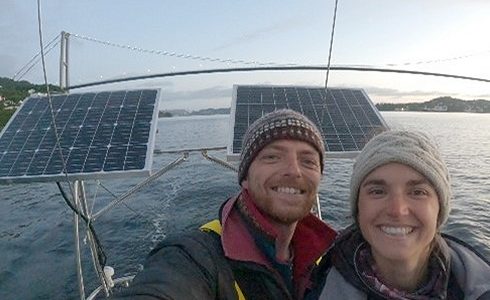In a post-pandemic, post-graduation daze – we found ourselves window shopping for a more seaworthy vessel than our sleek quarter tonner, an Eygthene 24. Fast forward a month of deliberation and we were the proud new owners of a 1978 Rival 32, which we found by chance, on the Isle of Bute in the Clyde. We were very pleased to inspect the Kemp Sails that came with the boat; a triple reefed, battened mainsail and furling genoa – both in great condition, having hardly been used.
After another month of refitting in the yard, we splashed in August 2020 and got to know our stout new boat alongside the pontoons of Port Bannatyne Marina. We had replaced all standing rigging, fitted a new furling system for the genoa, serviced the engine and added a new electrical system. Our sea-trial was a 150 nautical mile run around the notorious Mull of Kintyre, northwards past the Isle of Jura and into Oban, where we would spend the rest of the season cruising the Inner Hebrides, and then haul out for a bigger refit. Following a fruitful winter of long yard days and modern upgrades, we launched and set sail in May 2021 for the Shetland Isles, the UK’s most northern territory.
The 350 nautical mile passage would take us west through the Sound of Mull, pointing the bow for the Isle of Lewis in the Outer Hebrides. We approached Ardnamurchan point, mainland Britain’s most westerly point, and a gateway to Scotland’s northwest guarded by the towering Stevenson’s lighthouse. Rounding the headland by boat is a rite of passage, shrouded in nautical history and traditionally celebrated by fixing a sprig of white heather to the bow. Depending on the weather and tides here, the sailing conditions can be demanding as the narrow Sound of Mull meets the wide and exposed North Atlantic. These environmental conditions attract vast numbers of cetaceans to the area, with Minke Whales and common dolphins both showing up and accompanying us on passage.
Close-hauled across the Minch, we pressed on through the night to tie up in Stornoway before the arrival of a front. Bioluminescent algae flashed and sparked in our wake as we rode the swell, mimicking the stars overhead. Casting-off from Stornoway gave us enough northerly in our bearing, that it was a straight shot NE passage, rounding Cape Wrath to reach our 60°N destination. We quickly discovered Shetland’s rich cruising grounds, with endless anchorages devoid of other boats. It’s famously windy up here, but provided you have an effective reefing system there’s endless exploring to be done. We have been impressed with our Kemp Sails canvas, the heavy cloth holding up to cold and heavy winds. We regularly sail with a second reef if it’s to be over 20 knots, and the heavily reinforced reef points do a great job in maintaining a flat cut.
Shetland is the perfect launching point for high-latitude cruising, with the Norwegian coast or the Faroe Isles reachable within two days sailing. Naturally we began seeking distant horizons, and the early winds of June 2022 favoured a trip to the fjords of Norway. Broad-reaching across the North Sea in a SW F6, we realised the true potential of our Rival as a bluewater cruiser. The heavy displacement and swept bow make for an easy motion in a seaway, and a relatively dry deck.
We made landfall in Bergen after a respectful 36-hour crossing, and after catching up on sleep, made our way into the endless network of fjords that connect this nautical nation. Again, we had most anchorages to ourselves, and we explored by hiking, swimming and fishing from the boat. The deep and fast flowing, steep sided fjords conform to produce exciting training grounds with constant attention required to the wind direction. One drastic wind shift saw us douse the asymmetric spinnaker and haul the boom up for a close-hauled beat with no change to the compass bearing!
By a stroke of luck on our return trip to Shetland, a SE F6 was forecast and we enjoyed similar conditions to our trip over, averaging speeds of 7 knots at points. We snuck past towering oil rigs and made landfall on Shetland in thick, summer fog – after 39 hours at sea. Our season was far from over yet though, and in July we cast off for a dream destination in the North; Fair Isle. Famous amongst long-distant cruisers, Fair Isle is like the Azores of the North, offering respite to boats on eastern and western passages. We encountered some lively seas on our way down, as the strong south-going tide converged with big westerly swells. North Haven on Fair Isle provided us with welcome shelter in amongst boats on transit to Faroe and Norway, and we met an eclectic bunch of like-minded folks from France, Norway, Ireland, Faroe, Alaska and Scotland.
Sailing to Papa Stour in September was a polar opposite experience, as we had the remote island almost to ourselves – except the shirtless crofters on quad bikes and giant grey seals we shared the anchorage with. As Autumn arrived, we got out in heavier weather as much as we could, testing our newly installed inner forestay with a scrap of hanked-on jib. Since stepping the mast in December, we’ve hunkered down and kept the stove going aboard – planning for 2023’s adventure and installing safety gear. Our first destination in the spring is Lofoten, in Arctic Norway!





